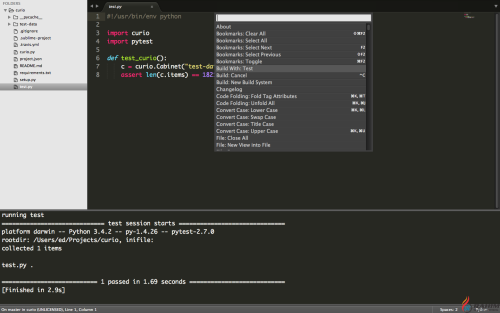- Apple Mac OS Classic (3) BeOS (1) BSD/OS (1) Console-based Platforms (3). This PL/SQL package converts a query with a sdogeometry into an ESRI shape file and a.
- PL/SQL Developer by IFS Allround Automations is a feature-rich Integrated Development Environment (IDE) that was designed to help users develop units for Oracle databases using PL/SQL programming. Sadly, there is no version of PL/SQL Developer for Mac, but there are some other tools that can prove to be quite useful.
This chapter describes how to build and run the SQL*Loader and PL/SQL demonstration programs available with Oracle Database. It contains the following sections:
OpenBase SQL is a database server application that provides high-speed access to structured data. SQL stands for Structured Query Language and is the mechanism by which client applications are.
Note:
To use the demonstrations described in this chapter, you must install the Oracle Database Examples included on the Oracle Database 10g Companion CD.You must also unlock the JONES account and set the password before creating the demonstrations.
7.1 SQL*Loader Demonstrations
Run the ulcase.sh file to run the SQL*Loader demonstrations. To run an individual demonstration, read the information contained in the file to determine how to run it.
7.2 PL/SQL Demonstrations
PL/SQL includes a number of demonstration programs. You must build database objects and load sample data before using these programs. To build the objects and load the sample data:
Change directory to the PL/SQL demonstrations directory:
Start SQL*Plus, and connect as JONES/
password:Run the following commands to build the objects and load the sample data:
Note:
Build the demonstrations as any Oracle user with sufficient privileges. Run the demonstrations as the same Oracle user.
PL/SQL Kernel Demonstrations
The following PL/SQL kernel demonstrations are available with the software:
examp1.sqltoexamp8.sqlexamp11.sqltoexamp14.sqlsample1.sqltosample4.sqlextproc.sql
To compile and run the exampn.sql or samplen.sql PL/SQL kernel demonstrations:
Start SQL*Plus, and connect as JONES/
password:Run a command similar to the following to run a demonstration, where
demo_nameis the name of the demonstration:
To run the extproc.sql demonstration:
If required, add an entry for external procedures to the
tnsnames.orafile, similar to the following:If required, add an entry for external procedures to the
listener.orafile, similar to the following:Note:
The value that you specify for SID_NAME in thelistener.orafile must match the value that you specify for SID in thetnsnames.orafile.On HP-UX, Linux, Solaris, and Tru64 UNIX:
On AIX:
On Mac OS X:
Change directory to
$ORACLE_HOME/plsql/demo.Run the following command to create the
extproc.soshared library, build the required database objects, and load the sample data:Note:
On Mac OS X systems, use the shared library nameextproc.dylibin the following examples.Alternatively, if you have already built the database objects and loaded the sample data, then run the following command:
From SQL*Plus, run the following commands:
To start the demonstration, run the following command:
PL/SQL Precompiler Demonstrations
Note:
Themake commands shown in this section build the required database objects and load the sample data in the JONES schema.The following precompiler demonstrations are available:
examp9.pcexamp10.pcsample5.pcsample6.pc
To build the PL/SQL precompiler demonstrations, set the library path environment variable to include the $ORACLE_HOME/lib directory, and run the following commands:
To build a single demonstration, run its name as the argument in the make command. For example, to build the examp9 demonstration, run the following command:
To start the examp9 demonstration, run the following command:
7.3 Calling 32-Bit External Procedures from PL/SQL
Note:
This section applies to AIX, HP-UX, Solaris SPARC, zSeries Linux, and Apple Mac OS X (Intel).The 64-bit external procedure executable (extproc) and the 32-bit external procedure executable (extproc32) are installed in the $ORACLE_HOME/bin directory. By default, the extproc executable is enabled to run 64-bit external procedures on AIX, HP-UX, Solaris SPARC, and zSeries Linux systems. To enable 32-bit external procedures:
Set the value of the
PROGRAMparameter in thelistener.orafile as follows:Include the
$ORACLE_HOME/lib32directory in one of the following environment variables, depending on your platform:Platform Environment Variable AIX LIBPATHHP-UX SHLIB_PATHLinux on POWER, zSeries Linux, and Solaris LD_LIBRARY_PATHApple Mac OS X (Intel) DYLD_LIBRARY_PATHRestart the listener.
Note:
You can configure a listener to run either 32-bit or 64-bit external procedures, but not both at the same time. However, you can configure two listeners if you have to support both 32-bit and 64-bit external procedures.
This User Tip describes how to download, install, and setup MySQL for use on OS X. It includes an optional section for Perl support. Please read through the entire User Tip before starting.
Requirements:
- Basic understanding of Terminal.app and how to run command-line programs.
- Basic usage of vi. You can substitute nano if you want.
Optional:
Xcode (with command line tools) is required for the MySQL Perl driver.
Lines in bold are what you will have to type in at the Terminal.
Replace <your local host> with the name of your machine. Ideally, it should be a one-word name with no spaces or punctuation. It just makes life easier.
Replace <your short user name> with your short user name.
Download MySQL from a local mirror. You want the Mac OS X ver. 10.6 (x86, 64-bit), DMG Archive. At the time of writing this User Tip, the current version is 5.5.34. By the time you read this, there may be a newer version to use instead. Open the archive mysql-5.5.34-osx10.6-x86_64.dmg.
Install only the mysql-5.5.34-osx10.6-x86_64.pkg package. Ignore everything else.
MySQL comes with a Preference Pane and Startup Item that are based on technologies that Apple deprecated years ago. If you install the Preference Pane or Startup Item, your MySQL installation could fail at some point in the future when Apple removes support for Startup Items. This was reported to MySQL a long time ago. Until MySQL gets around to fixing this bug, we will have to do it ourselves.
Create a launchd config file for MySQL:
sudo vi /Library/LaunchDaemons/com.mysql.mysql.plist
Use the following content:
<?xml version='1.0' encoding='UTF-8'?>
<!DOCTYPE plist PUBLIC '-//Apple//DTD PLIST 1.0//EN' 'http://www.apple.com/DTDs/PropertyList-1.0.dtd'>
<plist version='1.0'>
<dict>
<key>KeepAlive</key>
<true/>
<key>Label</key>
<string>com.mysql.mysqld</string>
<key>ProgramArguments</key>
<array>
<string>/usr/local/mysql/bin/mysqld_safe</string>
<string>--user=mysql</string>
</array>
</dict>
</plist>
(if you are new to vi, type 'i' to enter insert mode. Then ⌘-v to paste the above content. Press escape to get back to command mode. Then type 'ZZ' to save and exit.)
The default path for the MySQL socket is not appropriate for MacOS X. Until it is changed, MySQL will not be able to communicate with PHP should you choose to enable that. Let's fix this now.
Create a config file for MySQL that matches the Apple PHP build:
sudo vi /etc/my.cnf
Use the following content:
[client]
socket=/var/mysql/mysql.sock
[mysqld]
socket=/var/mysql/mysql.sock

Start MySQL:
sudo launchctl load -w /Library/LaunchDaemons/com.mysql.mysql.plist
MySQL is now up and running. Don't forget to set a root password and configure your users if this is all you need.
If you need to configure Perl support for MySQL, don't setup a root password just yet. Having no password will make testing the Perl module easier. Keep reading...
You will need Xcode and command line tools for this part.
Download the MySQL Perl driver.
Extract the archive with:
tar zxvf DBD-mysql-4.020.tar.gz
Move into the directory:
cd DBD-mysql-4.020
First, fix the MySQL client library. (credit)
For Lion, type:
sudo install_name_tool -id /usr/local/mysql-5.5.34-osx10.6-x86_64/lib/libmysqlclient.18.dylib /usr/local/mysql-5.5.34-osx10.6-x86_64/lib/libmysqlclient.18.dylib
Next, build DBD::mysql with:
perl Makefile.PL --mysql_config=/usr/local/mysql/bin/mysql_config --testsocket=/var/mysql/mysql.sock --testuser=root

make
Pl Sql Developer Mac Os X
make test
sudo make install
Pl Sql For Mac Os 10.13
Pl Sql For Mac Os High Sierra
Now you can set a root password and configure your users.